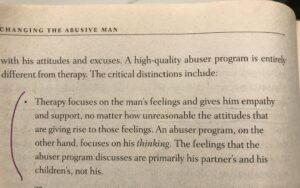
- Committing to outside help (there is no “working on myself by myself”)
- Admitting fully to what he has done
- Stopping excuses
- Stopping all blaming
- Making amends for what has been done
- Accepting responsibility (recognizing that abuse is a choice)
- Identifying patterns of controlling behavior, admitting their wrongness
- Identifying the attitudes that drive his abuse
- Accepting that overcoming abusiveness will be a decades-long process, not declaring himself cured
- Not starting to say, “so now it’s your turn to do your work”, not using change as a bargaining chip
- Not demanding credit for improvements he has made
- Not treating improvements as chips or vouchers to be spent on occasional acts of abuse (e.g. “I haven’t done anything like this in a long time, so why are you making such a big deal about it?”)
- Developing respectful, kind, supportive behaviors
- Carrying his weight
- Sharing power
- Changing how he is in highly heated conflicts
- Changing how he responds to his partner’s (or former partner’s) anger and grievances
- Changing his parenting
- Changing his treatment of her as a parent
- Changing his attitudes towards females in general
- Accepting the consequences of his actions (including not feeling sorry for himself about those consequences, and not blaming her or the children for them)
Adapted from Lundy Bancroft’s website.
